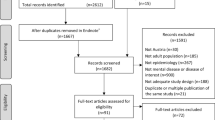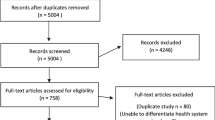Abstract
Background
Mental and physical non-communicable diseases (NCDs) coexist, because they share common environmental and behavioral risk factors. The treatment gap for common mental disorders, such as depression, anxiety, and substance use, is large compared to other NCDs.
Objective
To determine the prevalence and treatment gap of common mental disorders among patients with non-communicable diseases.
Methodology
The community-based cross-sectional study was conducted in the rural parts of East India, in people aged 30 years and older with NCDs. A simple random sample was chosen to select the villages and participants. Eligible participants administered with screening and diagnostic questionnaire for depression, anxiety, and substance use. Those diagnosed with mental disorders were again assessed for treatment status in the last 12 months. Non-receipt of treatment was considered as treatment gap.
Results
A total of 515 participants were included in the analysis. The overall prevalence of common mental disorders among the study population was 46.4% (95% CI 42.0–50.8), and excluding substance use, the prevalence was 11.7% (95% CI 9.0–14.7). The treatment gap for common mental disorders among patients with non-communicable diseases, including and excluding substance use, was 98.3% (95% CI 95.8–99.5) and 93.3% (95% CI 83.8–98.2), respectively.
Conclusion
The prevalence and treatment gap of common mental disorders among persons with NCDs was high. Public health interventions need to be emphasized for the integration of mental health care into NCD care.

Similar content being viewed by others
References
Hypertension [Internet]. World Health Organization. 2021. Available from: https://www.who.int/news-room/fact-sheets/detail/hypertension. Accessed 10 Dec 2022
Diabetes facts & figures [Internet]. International Diabetes Federation. 2021. Available from: https://idf.org/aboutdiabetes/what-is-diabetes/facts-figures.html. Accessed 10 Dec 2022
Saeedi P, Petersohn I, Salpea P, Malanda B, Karuranga S, Unwin N et al (2019) Global and regional diabetes prevalence estimates for 2019 and projections for 2030 and 2045: results from the International Diabetes Federation Diabetes Atlas, 9th edition. Diabetes Res Clin Pract 157:107843
Zhou B, Carrillo-Larco RM, Danaei G, Riley LM, Paciorek CJ, Stevens GA et al (2021) Worldwide trends in hypertension prevalence and progress in treatment and control from 1990 to 2019: a pooled analysis of 1201 population-representative studies with 104 million participants. Lancet (London, England) 398(10304):957–980
Mental disorders [Internet]. World Health Organization. 2022. Available from: https://www.who.int/news-room/fact-sheets/detail/mental-disorders. Accessed 10 Dec 2022
Dandona L, Dandona R, Kumar GA, Shukla DK, Paul VK, Balakrishnan K et al (2017) Nations within a nation: variations in epidemiological transition across the states of India, 1990–2016 in the global burden of disease study. Lancet 390(10111):2437–2460
Gautham MS, Gururaj G, Varghese M, Benegal V, Rao GN, Kokane A et al (2020) The National Mental Health Survey of India (2016): prevalence, socio-demographic correlates and treatment gap of mental morbidity. Int J Soc Psychiatry 66(4):361–372
Armstrong K, Henshall S (2013) Mental health, NCDs and the post-2015 development goals a focus on children and adolescents in low-and middle-income countries. Commonw Heal Partnersh 33–8
Michael R, Korff V, Scott KM, Gureye O (2009) Global perspectives on mental-physical comorbidity in the who world mental health surveys. Cambridge University Press
Uphoff EP, Newbould L, Walker I, Ashraf N, Kandasamy A, Meader N et al (2019) A systematic review and meta-analysis of the prevalence of common mental disorders in people with non-communicable diseases in Bangladesh, India, and Pakistan. J Glob. https://doi.org/10.7189/jogh.09.020417
O’Neil A, Jacka FN, Quirk SE, Cocker F, Taylor CB, Oldenburg B et al (2015) A shared framework for the common mental disorders and non-communicable disease: key considerations for disease prevention and control. BMC Psychiatry 15(1):1–6
Gururaj GVM (2016) National mental health survey of india, 2015–2016 Prevalence, Pattern and Outcome. NImhans Rep 2015–2016
Ministry of Law and Justice (2013) The National Food Secrity Act 2013
Daré LO, Bruand P, Gérard D, Marin B, Lameyre V (2019) Co-morbidities of mental disorders and chronic physical diseases in developing and emerging countries : a meta-analysis. BMC Pub Health. https://doi.org/10.1186/s12889-019-6623-6
Hussain S, Habib A, Singh A, Akhtar M, Najmi AK (2018) Prevalence of depression among type 2 diabetes mellitus patients in India: a meta-analysis. Psychiatry Res 270:264–273
Sagar R, Pattanayak RD, Chandrasekaran R, Chaudhury PK, Deswal BS (2017) Twelve-month prevalence and treatment gap for common mental disorders : findings from a large-scale epidemiological survey in. Indian J Psychiatry 59(1):46–55
Subramaniam M, Abdin E, Vaingankar JA, Shafie S, Chua HC, Tan WM et al (2020) Minding the treatment gap: results of the Singapore mental health study. Soc Psychiatry Psychiatr Epidemiol 55(11):1415–1424
Andrade et al (2014) Barriers to mental health treatment: results from the WHO World mental health surveys. Pschological Med 44(6):1303–1317
Funding
Varsha Rajan received partial support for MD thesis from Indian Council of Medical Research New Delhi, Reference No.3/2/June-2020/PG-Thesis-HRD (36) dated 02-09-2020.
Author information
Authors and Affiliations
Contributions
The authors confirm their contribution to the paper as follows: Study conception and design: BKP, SP, PB, AKS. Data Collection: VR. Analysis and Interpretation of Results: BKP, VR, PB. Draft Manuscript preparation: VR, BKP. All authors reviewed the results and approved the final version of the manuscript
Corresponding author
Ethics declarations
Conflict of interest
The authors declare no competing interests.
Ethical approval
The study was approved by IEC AIIMS Bhubaneswar (Ref. Number: IEC/AIIMS BBSR/PG Thesis/2020-21/49). The written informed consent form was obtained from every participant.
Rights and permissions
Springer Nature or its licensor (e.g. a society or other partner) holds exclusive rights to this article under a publishing agreement with the author(s) or other rightsholder(s); author self-archiving of the accepted manuscript version of this article is solely governed by the terms of such publishing agreement and applicable law.
About this article
Cite this article
Rajan, V., Behera, P., Patra, S. et al. Prevalence of common mental disorders and treatment gap among patients with non-communicable diseases in the rural areas of East India. Soc Psychiatry Psychiatr Epidemiol (2024). https://doi.org/10.1007/s00127-024-02618-0
Received:
Accepted:
Published:
DOI: https://doi.org/10.1007/s00127-024-02618-0




